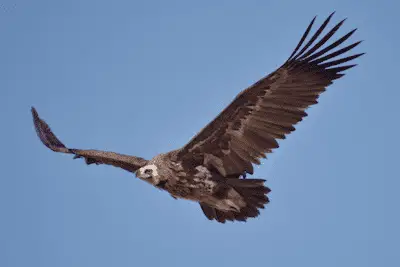Cinereous Vulture
(Aegypius monachus)
The Cinereous Vulture is Europe’s largest raptor, reaching a wingspan of almost 3 meters.

However, it is also one of the rarest raptors in Europe, and requires sustained conservation efforts in order to ensure its survival.
Two hopeful signs in this regard are the strong increase of the population of the Cinereous Vulture in Spain, as well as its successful reintroduction in France.
If we build on these positive developments, then we’re on a good road to saving the Cinereous Vulture in Europe.
Cinereous Vulture facts
As the largest vulture in Europe, the Cinereous Vulture feeds almost exclusively on carrion, and requires a habitat with stable populations of medium sized mammals that provide its food source.
Cinereous Vulture Size
As the largest raptor species in Europe, the Cinereous Vulture is hard to overlook, especially when it takes to the air and soars and glides with its wings fully extended.
- Cinereous Vulture wingspan: 255-295 cm
- Length: 100-112 cm
- Weight: 7,600-12,500 g (females), 7,000-11,500 g (males)
The long wingspan of this raptor is most apparent when it slowly soars on thermal currents around hillsides in search of carrion, which it can spot from many miles away.
Appearance
The Cinereous Vulture is almost entirely dark brown or black, and has a bald region without feathers on its face surrounding the huge beak. When flying, this bird of prey superficially resembles a very large eagle, such as the White-tailed Eagle, but is even bigger and of darker color.

Sexual dimorphism
Similar to many other raptor species in Europe, female Cinereous Vultures are larger than males, but this size difference between the sexes is not as pronounced as with many other raptor species.
Lifespan
With a maximum age of 39 years documented in captivity, the Cinereous Vulture has one of the longest lifespans of all European raptors.
Scientific name and taxonomy
The scientific name of the Cinereous Vulture is Aegypius monachus. No other subspecies is known, which makes it a monotypic species, which is rare among birds.
Cinereous Vulture distribution
The European population of Cinereous Vultures is predominantly found in the Western Mediterranean, as well as several smaller populations in Eastern Europe. The largest population is found in Spain, which currently has about 1,600 breeding pairs. Outside of the European part of its range, this bird occurs in the Middle East, Central Asia, and as far east as Japan and Kora.
Cinereous Vulture habitat
The Cinereous Vulture prefers hills and mountains in arid zones, but can also be found in lowland areas. Requires forests with old trees for nesting sites, but otherwise often forages far away from forests, including above the tree line of mountains.
Cinereous Vulture population size
The European population size of the Cinereous Vulture is estimated to be around 1,900 breeding pairs, of which the majority (1,600) are found in Spain. The Spanish population has grown from a few hundred breeding pairs in the 1970’s to the current number, which is a very encouraging sign that conservation efforts are paying off.
The total global population of the Cinereous is estimated to be between 7,000 and 10,000 pairs, which makes it a rare species overall.
Cinerous Vulture behavior
The Cinereous Vulture spends a large part of its time soaring on thermal currents around hills and mountains, which allows it to search large areas for dead animal carcasses without expending a lot of energy.
Feeding and diet
The diet of the Cinereous Vulture consists almost entirely of carrion, although it is capable of killing small animals that are already injured or sick. It feeds on carrion of any species and size, and due to its huge beak is able to open up the carcasses of large animals without problems.
However, in some areas, smaller animals, such as rabbits can form a large part of its diet. It is often found feeding at the same carcasses as Eurasian Griffon Vultures.
Breeding
The Cinereous Vulture starts breeding between 4 and 5 years of age. Builds a very large nest on old trees or on cliffs, and likes to form colonies with other vulture species in areas with plentiful food supply. Lays one egg, which is incubated for 50 to 60 days. After hatching, the nestlings require 100-120 days before leaving the nest, which is the longest of any European raptor species.
Migration
The Cinereous Vulture is considered to be a partial migrant, with the adult population being largely sedentary, while young birds can move over very large areas, and spend the winter away from the breeding grounds of their parents. Because of this, these raptors can be encountered far away from their breeding range.
Cinereous Vulture conservation status
While the Cinereous Vulture is one of the rarest raptor species in Europe (and in the world), and is hence classified as “Near Threatened” by IUCN and BirdLife, there is also a lot of cause for hope.
The Spanish population has grown significantly over the past 50 years, from a few hundred pairs in the 1970’s to more than 1,500. Also, the Cinereous Vulture has been successfully reintroduced into the Southern part of France, which now houses a small but stable population.
However, in many other parts of its range, local populations consist of just a handful of pairs, which makes them extremely vulnerable to adverse events. Because of this, the Cinereous Vulture needs to be closely monitored, and additional reintroduction efforts should be undertaken to ensure its survival.
Threats
The biggest threat to Cinereous Vultures is illegal poisoning, which is often targeted at other raptor species or mammals such as wolves or foxes, but hits Cinereous Vulture populations the hardest, since they feed almost entirely on carrion.
In addition to poisoning, the Cinereous Vulture is also threatened by deforestation, forest fires, and electrocution. All of these need to be monitored and managed in order to ensure that the Cinereous Vulture has a chance of surviving.
Additional resources:
- Bearded Vulture distribution and habitat
- Egyptian Vulture feeding and diet
- Spanish Imperial Eagle population size
